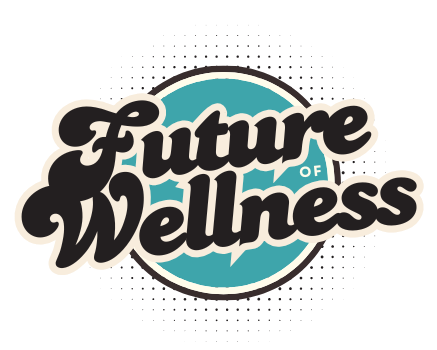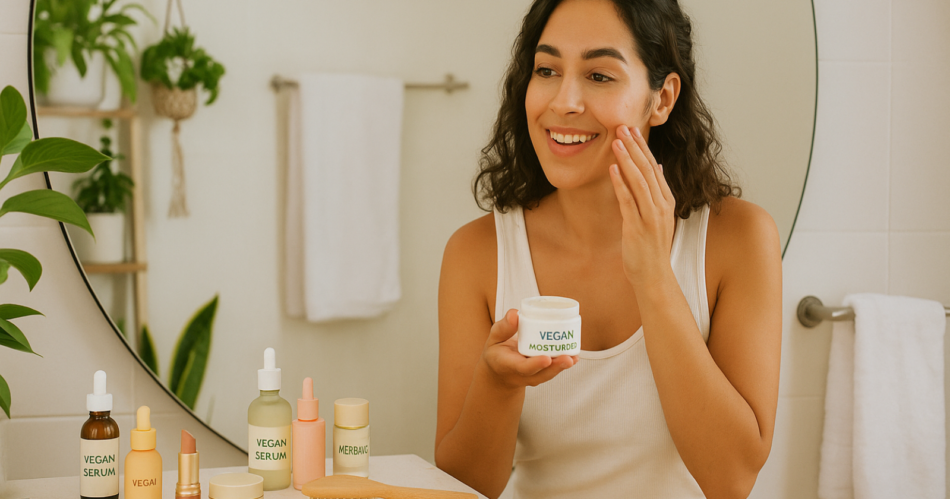I’m a chef. Ingredients are my love language.
If I won’t put something on my plate, why am I massaging it into my face?
That question hit me one night while reading a lipstick label that ran longer than a prix fixe menu.
I’d been edging toward vegan beauty for years—buying cruelty-free here, a plant-based balm there—but my bathroom still looked like a mixed pantry: beeswax in my lip color, lanolin in my hand cream, and a hair mask that smelled like a candy shop and worked about as well.
So I made a clean break and gave myself a cook’s challenge: 30 days, fully vegan, no exceptions.
I set ground rules the way I set mise en place:
- “Vegan” meant no animal-derived ingredients—no beeswax, lanolin, carmine (the red pigment from beetles), keratin, collagen, silk, or snail mucin.
- Cruelty-free” meant I looked for third-party certifications (Leaping Bunny, PETA, The Vegan Society).
- I promised to keep the science—and my skin—front and center.
That meant patch testing every new product on my inner arm for 48 hours, changing only one category at a time, and tracking my skin like a sous-chef logs prep: texture, breakout frequency, oil at noon, makeup wear by 6 p.m., and whether my sunscreen made me look like I’d rolled in flour.
My baseline complexion?
Combination skin with a T-zone that slicks up with the afternoon espresso, cheeks that get dramatic in dry weather, and a monthly pimple that arrives right on schedule, like rent.
Decoding labels without losing your mind
Vegan beauty is not a legally regulated term in most places, and green leaves on the box don’t guarantee anything except clever graphic design.
I learned to read INCI (the ingredient list) like a recipe. When a formula bragged about “collagen,” I checked whether it was the new plant or microbial kind (often labeled “soluble collagen” or “yeast extract”) versus animal-derived.
When a balm listed “wax,” I looked for candelilla or carnauba—plant waxes that stand in for beeswax.
For moisturizers, I hunted glycerin and squalane (plant-derived, often from sugarcane or olives), ceramides, and oat or rice extracts.
For makeup pigments, I scanned for iron oxides and synthetic fluorphlogopite (a lab-made mica alternative) instead of carmine or mined mica with murky sourcing.
It sounds intense, but after a week, it felt like checking salt levels in a sauce—habit, not homework.
One mental trick helped: If the marketing copy shouts and the INCI whispers, I trust the whisper.
The swaps that actually worked (face, body, hair)
Here’s where the kitchen metaphors meet the mirror. These are the categories where vegan formulas delivered the goods—and why they played nicely with my skin.
1) Cleansers (the soufflé of skincare—delicate, make-or-break):
Creamy, fragrance-light cleansers with oat, glycerin, and mild surfactants cleared sunscreen without stripping my cheeks. Oil cleansers made from sunflower or safflower oils melted mascara quickly and rinsed clean with a warm cloth. Sulfate-free mattered; my skin stayed calmer when the cleanse felt like warm milk, not a scalding scrub.
2) Moisturizers (the stew—slow, steady, satisfying):
Midweight gel-creams with plant squalane + glycerin + a humectant cocktail did the heavy lifting. My forehead stopped flashing neon by noon, and my cheeks didn’t beg for a top-off by 3 p.m.
Formulas with niacinamide and panthenol soothed post-peel crankiness without clogging. Bonus: swapping lanolin for shea and cupuaçu butters gave me the slip I like without the waxy film.
3) Sunscreen (the non-negotiable—like salt):
I went mineral and vegan with zinc oxide formulas. The trick was finding tints that used iron oxides to neutralize white cast. Two thin layers beat one thick one, and letting each layer “set” for a minute stopped pilling under makeup. My afternoon mirror check went from “ghost at the farmers’ market” to “alive and protected.”
4) Body care (the sheet-pan dinner—minimal, effective):
Plant-based body lotions with urea, glycerin, and shea butter kept my shins from auditioning as chalkboards. A simple lactic-acid body serum twice a week turned KP bumps on my arms into a memory without the barnyard scent some non-vegan formulas carry.
5) Hair care (the salsa—balance acid, fat, and salt):
Silicone-light conditioners with amino acids + fermented rice water left my curls shiny but not slippery. Protein-heavy masks (even vegan ones) can make hair crispy if you overdo it; alternating a protein-light, glycerin-rich mask brought bounce back.
A plant-wax edge tamer kept flyaways in check without beeswax concrete.
What didn’t work (and how I fixed it)
Not every swap was applause-worthy. Vegan doesn’t mean perfect—just like organic tomatoes can still be mealy if they’re out of season.
1) Lip balm without beeswax:
My first picks felt like oil that waved hello and then left. The fix was candelilla or carnauba wax paired with plant butters plus a touch of triglycerides for cling.
I also stopped chasing the instant “sealed” feel; the lighter slip actually made lipstick sit better.
2) Red lipstick without carmine:
Carmine is the notorious beetle-based red. Some vegan reds skew brick or fuchsia. I found success with iron oxide + D&C Red lakes blends, and I learned to layer: a neutral lip pencil underneath deepened the tone, and a dab of concealer around the edges stopped feathering.
3) Mascara drama:
Beeswax-free mascaras can flake or refuse to lift.
The winning combo: rice bran wax + sunflower wax and a curved brush. I also stopped fighting humidity with extra coats and accepted that one volumizing pass plus a clean lash comb beats three gloopy layers and raccoon eyes.
4) Fragrance floods:
A few “natural” perfumes blasted me like standing inside a florist’s fridge. Plant-based doesn’t mean low intensity. I switched to rollerballs and pulsed once at the wrists, then brushed a bit through my hair to disperse. If you’re sensitive, look for fragrance-free skincare and keep scent in one intentional step.
Makeup that survived a 12-hour chef shift
Kitchen heat is the ultimate stress test: steam, oil, and fluorescent lights that forgive nothing. Vegan base makeup stood out when it relied on film-formers like magnesium aluminum silicate rather than heavy oils.
A silicone-free primer with aloe + zinc PCA blurred without pilling under my mineral sunscreen.
For cheeks, cream sticks with plant waxes looked like skin and didn’t migrate. Brow products using synthetic beeswax held arches in place better than I expected—no crispy flakes, even when I leaned into oven heat.
Setting sprays?
I kept them minimal.
A fine mist with glycerin + betaine kept glow in the right zones; heavy alcohol sprays shrank my pores temporarily but left foundation crackly by hour six.
The budget problem (and the pantry solutions)
Vegan beauty can get pricey fast, especially when ethical sourcing and small-batch production meet glass bottles and pretty fonts.
My rule became “splurge on actives, save on basics.”
I happily paid more for a stable vitamin C serum that didn’t oxidize in two weeks and spent less on body lotion I used generously.
Pantry crossovers helped: cold-pressed grapeseed oil removed lipstick better than boutique balms, and a teaspoon of oat flour in my hand soap turned it into a gentle scrub after messy recipe testing.
For impulse control, I treated my bathroom like a restaurant walk-in: label open dates, use things up, no new purchases until something’s 80% gone. Boring? Sure. Effective? Absolutely.
Sensitive-skin strategy: how I avoided a “purge”
Any routine overhaul can rile up your skin.
Mine stayed surprisingly chill because I treated changes like a menu tasting, not a buffet. I swapped one category per week, starting with cleanser, then moisturizer, then sunscreen, then makeup.
I kept actives (retinoids, acids) steady and fragrance as low as possible.
Each new product got a 48-hour patch test on my inner arm and behind one ear. When a beautifully marketed night cream stung on contact, I didn’t negotiate—out it went.
Skin doesn’t care about sunk costs. Hydrocortisone (used sparingly) and a plain aloe gel repaired any grumbles within a day.
Sustainability check: beyond “vegan” on the box
As with food, ethics live beyond an ingredient list. I prioritized refill systems, recyclable glass or aluminum, and brands that publish micasourcing and worker-safety policies.
Where refills weren’t available, I chose larger sizes for things I blow through (cleanser, body lotion) to cut packaging per ounce.
For travel, I decanted into silicone bottles I’ve owned for years. My trash can got lighter and my top shelf calmer—fewer, better bottles instead of a teetering Jenga tower of “maybes.”
One month later: the results in living color
By week two, my cheeks stopped thirst-texting me at 3 p.m., and my foundation looked more like skin than theater makeup. By week three, the monthly pimple still showed up (hi, old friend) but healed faster and flatter.
Lips? Less peeling, even after a windy farmers’ market shop.
My hair settled into shiny, not slippery.
The biggest change, though, was emotional: my routine felt intentional. Like cooking, it turned from a chore to a ritual—heat water, cleanse slowly, pat—not rub—on moisturizer, press sunscreen, choose one bright pop (usually a vegan red) and go.
When something didn’t work, I didn’t ask “Is vegan the problem?” I asked “Which function is missing?” Then I filled the gap—more humectant, a better wax blend, a tint that matched undertones.
What I’d tell a friend starting tomorrow
If you want a gentle, realistic on-ramp, here’s the order I recommend—and why it saves both skin and money.
- Start with sunscreen. It’s the daily workhorse; everything else is dessert. Find a zinc-based, vegan formula you’ll actually wear.
- Then cleanser and moisturizer. These are your salt and fat—choose fragrance-light, barrier-kind options with glycerin/squalane and call it a day.
- Next, lips and brows. Tiny swaps (candelilla-wax balms, synthetic-beeswax brow gels) make a big visual difference.
- Finally, foundation and color. Once your base is happy, play. Vegan formulas shine in cream blushes and sheer lip bullets; they’re the fresh herbs of your face.
Set a 90-day budget cap, patch test, and keep notes. You don’t need a whole new vanity; you need a few well-chosen staples that do their jobs every single morning.
Final thoughts
I went vegan with my beauty routine out of curiosity — I’m staying because the results feel like walking out of a warm kitchen—soft light, clean surfaces, and the confidence that every ingredient had a reason to be there.
The wins weren’t flashy; they were cumulative: calmer cheeks, steadier T-zone, red lipstick that didn’t require a beetle’s sacrifice.
The flops taught me fast—thin balms need better waxes, bold reds need thoughtful pigments, and “natural” fragrance is still fragrance if your skin gets huffy.
If you’re tempted to try it, start with the daily staples and let performance, not promises, earn counter space.
Like a good recipe, a good routine is forgiving once you understand the fundamentals. And when it sings, you’ll know—the mirror smiles back, and you’re out the door smelling faintly of citrus and confidence.
What’s Your Plant-Powered Archetype?
Ever wonder what your everyday habits say about your deeper purpose—and how they ripple out to impact the planet?
This 90-second quiz reveals the plant-powered role you’re here to play, and the tiny shift that makes it even more powerful.
12 fun questions. Instant results. Surprisingly accurate.








